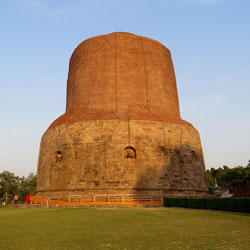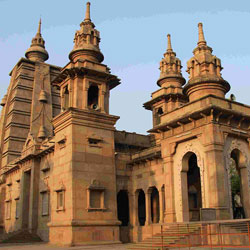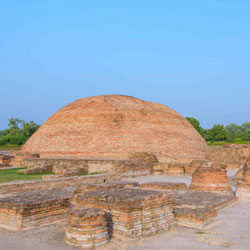
- Home
- Travel Packages
- Top Destination
-
Travel Attraction
By Category
Top Attraction

- Travel Agents
- Car Rentals
- Hotels

About the Dhamek Stupa, Sarnath History The Dhamek Stupa in Sarnath is a significant Buddhist monument that holds great historical importance. Built in 500 CE on the site where Lord Buddha is said to have delivered his first sermon after attaining enlightenment, the stupa symbolizes the spread of Buddhism. It was originally commissioned by the great Mauryan king Ashoka and has been renovated and reconstructed several times over the centuries. Architecture and Design The Dhamek Stupa stands at a height of 43.6 meters and has a diameter of 28 meters. It is constructed of red brick and stone and is adorned with intricate carvings and sculptures depicting scenes from the life of Buddha. The stupa's design showcases a unique blend of Gupta and Mauryan architectural styles, making it a masterpiece of ancient Indian craftsmanship. Best Time to Visit The best time to visit the Dhamek Stupa in Sarnath is during the winter months from November to February when the weather is pleasant and cool. This is also the peak tourist season, so visitors can enjoy the stupa in all its glory without the crowds that often flock there during the summer and monsoon seasons. Cultural Significance The Dhamek Stupa holds immense cultural significance as it marks the spot where Buddha gave his first sermon, known as the Dhammacakkappavattana Sutta. It is a place of pilgrimage for Buddhists from around the world, who come to pay their respects and gain spiritual enlightenment. The stupa is also a symbol of peace and harmony, promoting the teachings of non-violence and compassion. Pilgrimage Practices Visitors to the Dhamek Stupa are encouraged to participate in traditional Buddhist practices such as meditation, chanting, and offering prayers. Pilgrims often walk around the stupa in a clockwise direction, known as 'pradakshina', as a sign of respect and devotion. Many also bring offerings such as flowers, candles, and incense to offer at the stupa as a way of showing reverence to Buddha and seeking blessings. Dress Code and Etiquette It is important for visitors to the Dhamek Stupa to dress modestly and respectfully, covering their shoulders and knees as a mark of respect for the sacred site. Visitors should also remove their shoes before entering the stupa and maintain a quiet and respectful demeanor while on the premises. Taking photographs is allowed, but visitors should be mindful of not disturbing others or the sanctity of the place. Activities and Experiences Visitors to the Dhamek Stupa can engage in a variety of activities and experiences to enhance their spiritual journey. They can attend meditation sessions led by experienced teachers, participate in guided tours to learn more about the stupa's history and significance, and explore the nearby Buddhist temples and monasteries to gain a deeper understanding of the teachings of Buddha. Additionally, visitors can shop for religious souvenirs and handicrafts in the local markets to take home as mementos of their visit. Art and Religious Symbols The Dhamek Stupa is adorned with intricate carvings and sculptures depicting various religious symbols and scenes from the life of Buddha. These artworks serve as visual representations of Buddhist teachings and are meant to inspire and uplift visitors on their spiritual journey. The stupa's design and architecture also incorporate symbolic elements such as lotus flowers, wheel of Dharma, and Bodhi trees, which hold special significance in Buddhism. Local Insights Locals in Sarnath are proud of the Dhamek Stupa and see it as a symbol of their cultural heritage and religious identity. They are welcoming to visitors and are happy to share their knowledge and stories about the stupa and its significance. Locals often participate in traditional ceremonies and rituals at the stupa, providing visitors with a unique opportunity to witness and experience authentic Buddhist practices in action.
Explore More
About Chaukhandi Stupa, Sarnath History The Chaukhandi Stupa in Sarnath is a historical monument that dates back to the 5th century. It was originally built as a terraced temple to mark the spot where Lord Buddha met his first disciples, five ascetics, after attaining enlightenment. Over the years, the stupa has undergone various renovations and additions, making it an important archaeological site in Buddhism. Architecture and Design The Chaukhandi Stupa features a mixture of Hindu and Buddhist architectural styles. The stupa is built in a square shape with a terraced design, decorated with intricate carvings and inscriptions. The spire at the top of the stupa adds to its grandeur, making it a visually striking monument in Sarnath. Best Time to Visit The best time to visit the Chaukhandi Stupa in Sarnath is during the winter months from October to March when the weather is pleasant and ideal for sightseeing. The stupa can also be visited during festivals and special events when it is beautifully decorated and bustling with pilgrims and tourists. Cultural Significance The Chaukhandi Stupa holds immense cultural significance in Buddhism as it marks the spot where Lord Buddha gave his first sermon, known as the Dhammacakkappavattana Sutta. The stupa is a sacred place for Buddhists worldwide and is a symbol of the spread of Buddha's teachings. Pilgrimage Practices Visitors to the Chaukhandi Stupa often engage in pilgrimage practices such as offering prayers, lighting incense sticks, and circumambulating the stupa in a clockwise direction as a sign of respect and devotion. Pilgrims also meditate and chant mantras while visiting the stupa to seek blessings and enlightenment. Dress Code and Etiquette While visiting the Chaukhandi Stupa, it is advisable to dress modestly and respectfully. Visitors are encouraged to wear clothing that covers their shoulders and knees as a mark of respect for the sacred site. It is also important to maintain silence and avoid loud noises to preserve the peaceful atmosphere of the stupa. Activities and Experiences Visitors to the Chaukhandi Stupa can engage in a variety of activities and experiences, including exploring the intricate carvings and inscriptions on the stupa, participating in guided tours to learn more about its history, and attending special ceremonies and rituals conducted at the site. The stupa offers a serene and spiritual environment for contemplation and meditation. Art and Religious Symbols The Chaukhandi Stupa is adorned with intricate carvings and sculptures depicting various religious symbols such as lotus flowers, dharmachakras, and Bodhi trees, which are significant in Buddhism. The artistry and symbolism on the stupa reflect the rich religious and cultural heritage of Sarnath and attract art enthusiasts and spiritual seekers from around the world. Local Insights Local residents and guides in Sarnath offer valuable insights into the history and significance of the Chaukhandi Stupa. They provide visitors with a deeper understanding of the rituals and practices associated with the stupa and share fascinating stories and anecdotes related to its construction and preservation. Engaging with locals adds a personal touch to the visit and enriches the overall experience of exploring this ancient monument.
Explore More
Mulagandha Kuti Vihar, Sarnath About Mulagandha Kuti Vihar is a renowned Buddhist monastery located in Sarnath, India. It holds great significance for Buddhists as it is said to be the place where Buddha spent his first rainy season after attaining enlightenment. The monastery is known for its beautiful architecture and design, reflecting the rich Buddhist heritage of the area. History, Architecture, and Design Founded in 1931 by Anagarika Dharmapala, Mulagandha Kuti Vihar is a stunning example of Buddhist architecture. The monastery features intricate carvings, colorful murals, and serene gardens. The design of the vihar incorporates traditional Buddhist elements, creating a peaceful and spiritual atmosphere for visitors. Best Time to Visit The best time to visit Mulagandha Kuti Vihar is during the winter months of October to March when the weather is pleasant and ideal for sightseeing. Avoid visiting during the summer months as the temperatures can soar, making it uncomfortable for exploring the monastery. Cultural Significance As a sacred Buddhist site, Mulagandha Kuti Vihar holds immense cultural significance for followers of the faith. It is a place for meditation, reflection, and spiritual growth, attracting pilgrims and tourists from around the world. Pilgrimage Practices Pilgrims visiting Mulagandha Kuti Vihar often engage in prayers, meditation, and offerings as part of their spiritual practice. It is believed that visiting this monastery can bring blessings, peace, and enlightenment to those who seek it. Dress Code and Etiquette Visitors are advised to dress modestly when visiting Mulagandha Kuti Vihar out of respect for the religious significance of the site. Avoid wearing revealing clothing and be mindful of your behavior while on the monastery grounds. Activities and Experiences There are various activities and experiences to enjoy at Mulagandha Kuti Vihar, including guided tours, meditation sessions, and cultural performances. Visitors can also explore the beautiful gardens surrounding the monastery and take in the peaceful ambiance of the vihar. Art and Religious Symbols The monastery is adorned with intricate artwork and religious symbols that hold deep meaning for Buddhists. From Buddha statues to colorful paintings depicting Buddhist teachings, every corner of Mulagandha Kuti Vihar is filled with spiritual significance. Local Insights Local residents and monks offer insights into the history and significance of Mulagandha Kuti Vihar, providing visitors with a deeper understanding of the Buddhist faith and its practices. Engaging with the local community can enhance your experience and appreciation of this sacred site.
Explore More
About Stupa Complex, Balrampur History The Stupa Complex in Balrampur has a rich history dating back to ancient times. It is believed to have been built during the Mauryan Empire and later expanded during the Gupta Empire. The complex served as a center for Buddhist teachings and meditation, attracting pilgrims and scholars from far and wide. Architecture and Design The Stupa Complex in Balrampur is known for its intricate architecture and design. The main stupa is surrounded by smaller stupas, shrines, and monastic cells. The complex is adorned with intricate carvings, sculptures, and paintings depicting Buddhist teachings and stories. The design of the complex is a blend of Mauryan and Gupta architectural styles, showcasing the craftsmanship and artistry of the ancient builders. Best Time to Visit The best time to visit the Stupa Complex in Balrampur is during the winter months, from October to March. The weather is pleasant during this time, making it ideal for exploring the complex and enjoying the serene surroundings. Avoid visiting during the summer months as the heat can be intense and make it difficult to explore the complex comfortably. Cultural Significance The Stupa Complex in Balrampur holds immense cultural significance as a sacred site for Buddhists. It is believed to be the place where Lord Buddha gave teachings and performed miracles. Pilgrims from around the world visit the complex to pay their respects and seek spiritual enlightenment. The complex is a symbol of peace, harmony, and compassion, reflecting the core teachings of Buddhism. Pilgrimage Practices When visiting the Stupa Complex in Balrampur, pilgrims are encouraged to engage in traditional Buddhist practices such as meditation, chanting, and offering prayers. Pilgrims often circumambulate the main stupa in a clockwise direction as a form of respect and devotion. Many pilgrims also participate in rituals and ceremonies conducted by resident monks and nuns, seeking blessings and guidance on their spiritual journey. Dress Code and Etiquette Visitors to the Stupa Complex in Balrampur are expected to dress modestly and respectfully. It is recommended to wear clothing that covers the shoulders and knees out of respect for the sacredness of the site. Visitors are also encouraged to maintain a quiet and peaceful demeanor while exploring the complex, refraining from loud conversations or disruptive behavior. Photography may be allowed in certain areas, but it is important to ask for permission before taking any photos. Activities and Experiences Visitors to the Stupa Complex in Balrampur can engage in a variety of activities and experiences. They can participate in guided tours of the complex, learn about the history and significance of the site, and explore the intricate architecture and design of the stupas and shrines. Visitors can also attend meditation sessions, teachings, and ceremonies conducted by resident monks and nuns, offering a unique spiritual experience in a peaceful and serene setting. Art and Religious Symbols The Stupa Complex in Balrampur is adorned with exquisite art and religious symbols that hold deep significance in Buddhist teachings. The carvings, sculptures, and paintings depict scenes from the life of Lord Buddha, his teachings, and the path to enlightenment. Symbols such as the lotus flower, wheel of Dharma, and Bodhi tree are commonly found throughout the complex, representing key aspects of Buddhist philosophy and practice. Local Insights Local residents and guides can offer valuable insights into the history, culture, and significance of the Stupa Complex in Balrampur. They can share stories and legends associated with the site, provide information on traditional practices and rituals, and offer a deeper understanding of the spiritual significance of the complex. Engaging with locals can enhance the overall experience of visiting the complex, providing a deeper connection to the sacredness and beauty of the site.
Explore MoreMathura Goverdhan Barsana Car Tour
1 Day
Mathura - Vrindavan
5N/6D Spiritual Triangle with Naimisharanya
6 Days/ 5 Night
Lucknow - Ayodhya - Prayagraj - Varanasi - Sitapur
7N 8D Luxury Religious Travel Plan Tour
8 Days/ 7 Night
Prayagraj - Mirzapur - Varanasi - Ayodhya - Sarnath - Chitrakoot
2D - 1N Agra Tour Package
2 Days/ 1 Night
Agra